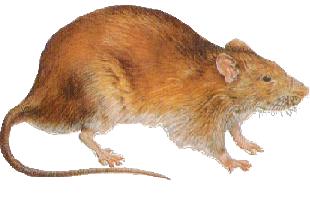
Biology and Life Habits
The Norway Rat is common in most parts of Canada. Rats attach the foods of man from the farm fields and orchards through the processing, storage and retail sales market.
They have a brownish gray upper body and a light grayish underbelly colour. They have small eyes and their tail is shorter than the combined length of their head and body. Average weight is 7 to 17 oz.
Rats have a life expectancy of about 9 months, but a female will have anywhere from 5 to 12 litters per year, with an average litter size of 7-11 young.
They are very agile climbers, excellent swimmers, and very suspicious and wary of the new objects, i.e. traps and bait stations.
They normally feed at night but once the population gets to be of a significant size they will feed during the day. Their teeth grow continually so the rat has to gnaw on objects, i.e. wood, pipes, and other objects to impede their growth.
Questions and Answers
Q. How can I tell if I have an infestation of rats?
A. Rat droppings near food sources is the most common indication of an infestation. Evidence of gnawing, rub marks, tracks, burrows, nests and damage to stored products are indications of the extent of an infestation.
Q. What can I do to prevent an infestation of rats?
A. Rats will invade almost any home or business, however, it is the presence of unsanitary conditions that encourages their activity. All goods must be stored in properly sealed jars or tins and waste should be prevented from accumulating, or kept in containers with tight fitting lids. Seal all openings to the outside, including wood around doors and windows; repair masonry and seal openings for utility lines, conduits and drains.
Q. Do rats cause damage?
A. World wide, rats are the most destructive pests known to man. Rats are known source of numerous diseases affecting man and his domesticated animals. Rats contaminate food and cause extensive damage to buildings and equipment in houses, granaries, restaurants, and bakeries – anywhere food is handled or stored. Rats will gnaw through wood and enlarge masonry openings to gain entrance into buildings. In the construction of their nests, rats destroy fabric and other dry goods and can cause fires by chewing through insulation on electrical wires.
Q. Are rats hazardous to humans?
A. Yes. Rats are a serious hazard to public health. Aside from contaminating food with their droppings and urine, fleas from rats were responsible for spreading the bubonic plague. Today, such diseases as salmonella bacteria (food poisoning), leptospira (jaundice), and typhus are commonly spread by rats. Because of their unsanitary habitats, secondary infections from rat bites can be serious and sometimes fatal. An infestation of rats must not be tolerated.
Q. When are rats most common?
A. Rats are year round pests. Under certain conditions, rats can survive outdoors during the winter, however activity and indoor migration increase as weather gets cooler and outdoor food and water sources decrease.
Q. Where do rats build nests?
A. Rats nest in any safe location near food and water. Outdoors, rats burrow into the ground. Indoors, nesting occurs in double walls, between ceilings and floors, closed in areas around counters and any area where rubbish is allowed to accumulate
Preparation Guidelines for Rat Treatment
1. Eliminate any food source and plug any holes or openings where rats may gain entry to the home;
2. If the rats are in the cupboards or closets, these areas should be cleared out so that control measures can be installed;
3. Children and pets should not be present when the service is being done;
4. Reliable is very safety conscious, and may use glue boards, snap traps, and live traps. These items are placed in areas that are as “out of view” as possible. If these devices are found, please do not move or touch them
5. If rodenticide bait is used, it is placed in locked stations in areas that are as inaccessible to children as possible. Please do not move or touch these stations;
6. Reliable will return after the extermination has been completed to remove all baits and traps. This should be arranged prior to service. If no arrangement has been made, the home owner can dispose of the control devices after the rat activity has ceased.
